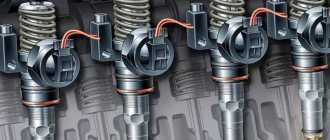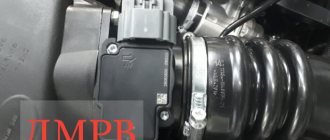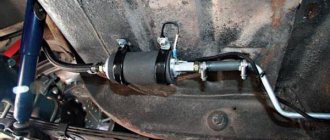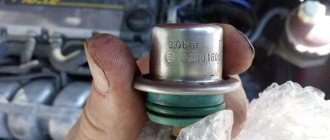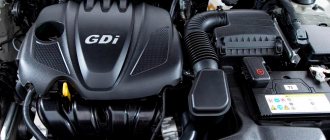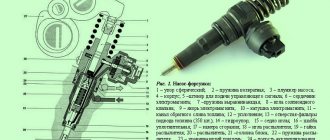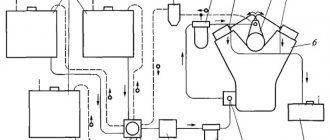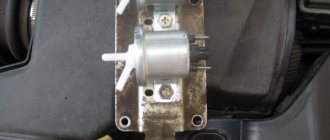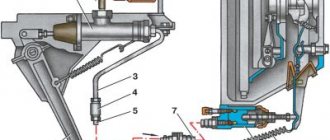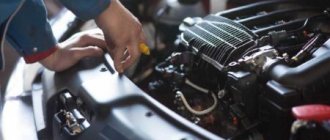Nowadays, the rapid development of technology contributes to the discovery of more practical and environmentally friendly inventions. Manufacturers of diesel fuel systems are constantly improving their units. If earlier the injectors were controlled, let’s say, mechanically, then later electrical elements appeared in the control of the fuel system. This made it possible to more accurately monitor and control the injection system. But the injectors themselves still remained a purely mechanical product, and their response speed depended on the parameters of the dynamic operation of these mechanical components.
In electromagnetic injectors of the first generations, the fuel supplied to the cylinder was divided into preliminary and main doses. But the injection system turned out to be more effective, where during one working stage of the injector, the fuel is divided into the maximum possible number of microportions.
To do this, it was necessary to increase the response speed of the control and actuator mechanisms of the injector. For this purpose, a piezoceramic nozzle was designed, which operates four times faster than a traditional electromagnetic one.
Typical defects in the operation of diesel engines with piezo injectors
Considering the specific design of this type of injectors, they add their own specific ones to all the “sores” of traditional electromagnetic ones.
Basically, they manifest themselves in this way: the car does not start well (does not start at all); stalls under load; troit; stalls at idle; when under load, traction is lost; the appearance of bluish smoke at idle and black under load.
The reasons for such defects in the operation of a car can be varied, but quite often we see the root cause in the injectors. Therefore, if you find such symptoms on your diesel engine, first of all undergo computer diagnostics. It is inexpensive and will help you save a good amount of money in your case.
If the diagnostics determines a loss (excess) of pressure in the system, a short circuit on the injectors, or a significant imbalance in the operation of the cylinders, then first pay attention to the injectors. Often this is where the cause of these problems lies.
What's the result?
The piezo injector is a high-tech component, originally intended to be replaced entirely and difficult to repair. But life dictates its own rules - services have appeared that have learned how to restore these parts so that the client is satisfied. All that remains is for non-original manufacturers to have their say and start producing analogues. And also to the manufacturers of original piezo injectors themselves, offering proprietary restoration technologies and spare parts for repairs.
Alexey Zubikov, head of development of the Bosch Diesel Center / Service network in Russia, Transcaucasia and Central Asia:
— To repair piezo injectors in Bosch Diesel Service workshops, the company does not yet have the technology, and kits of special tools and spare parts are not ready. At the moment we can only carry out diagnostics of injectors of this type. It is planned that we will begin providing repair services for piezo injectors in 2017–2018.
Source
Failure of piezo injectors and impact on engine operation
The piezo injector does not hold pressure - the precision part of the switching valve is damaged. As a result, the car has difficulty starting. It may also stall under load.
The injector is shorted to ground - the insulating layer of the piezoelectric element is damaged. In this case, the car does not start at all, or starts and after a short period of time stalls right at idle. Sometimes, with such a breakdown, the car stalls only under load. Most often we encounter such a defect on Trafic 2.0, less often on cars of the Volkswagen and Audi groups.
Sprayer failure . There are basically two options here: either the sprayer pours, or it jams in the closed position. In the first case, a weakly flowing atomizer produces light smoke at idle, which completely disappears under load. It appears on non-working nozzles after removing the particulate filter. Cars from the Mercedes group love to smell such light smoke, less often Audi and Crafter.
If the sprayer pours heavily (open wedge), then there will be more smoke. Black smoke also appears in the load, which is accompanied by a knocking noise. But such a defect has so far been observed very rarely.
When wedge is closed, the car idles (the wedge is felt more when there is low pressure in the system).
Depressurization of the drain line - mechanical damage to the elements of the drain line, failure of the check valve of this line. With such a breakdown, the car starts and runs, but stalls under light load. Quite often we see such damage on Trafic 2.0.
Insufficient capacity of the piezoelectric element (or weak resistance) - the piezoceramic element has failed. If this happens on one injector, then the car will fail. If the piezoelectric element loses capacity on several injectors, then the car may lose traction.
Repair cannot be changed
From a service point of view, the main feature of piezo injectors is the high complexity of repairs, which require special equipment. In some cases, repair is completely impossible. At the same time, the piezo injectors themselves are very demanding on the quality of the fuel, its composition and degree of purification, and if these levels are reduced, they quickly fail.
Piezo injectors for passenger car engines are produced by companies such as Bosch, Delphi, Denso and Siemens. But they are in no hurry to give this market to third-party repair services, offering a complete replacement. This component is quite expensive: depending on the brand and model, a piezo injector can cost from 16,000 to 40,000 rubles. Therefore, repairs, the average cost of which is half or less than the price of a new injector, are in demand. But not every service can do it.
The control valve most often fails. In this case, the part is manufactured with high precision and dimensions at the micron level.
Difficulties begin from the moment of diagnosis, which cannot be carried out in a garage workshop. For example, an overflow test, when tubes with cups are connected to the drain fittings into the return line, in a system with piezo injectors simply cannot be done like that, since there must be a pressure back-up “in the return”.
As servicemen say, the most vulnerable is the control valve, which fails most often. Moreover, it is one of the most important components - its malfunction can lead to failure of the entire nozzle. The valve is either replaced entirely or restored by grinding and lapping the working edge of the valve itself and the working edge of the valve seat. But this is not easy to do. The valve has a very high, precision manufacturing accuracy with measurement parameters at the micron level. For example, the collar at the top of a valve plug is about one hundred microns wide (one tenth of a millimeter), and there must be a certain chamfer angle. And the more accurately the factory parameters are reproduced, the easier it will be to configure the nozzle and the longer its service life will be.
Piezo injector structure
Section of a piezoelectric nozzle : 1 – drain line; 2 – electrical connector; 3 – piezoelectric element; 4 – high pressure channel; 5 – hydraulic cylinder; 6 – mating pistons; 7 – switching valve (multiplier); 8 – throttle plate; 9 – spray needle; 10 – over-needle chamber; 11 – exhaust throttle.
The piezoelectric injector can be divided into three parts:
control , hydraulic and actuating parts.
At the top we have the piezo element, her main “secret weapon”. In the middle is a hydraulic cylinder (another innovation) and a switching valve. And below we have a sprayer and a throttle plate (spacer). Now let's take a closer look at these nodes
Piezo element
This is a composite piezoelectric crystal (30-40 mm long), which consists of ceramic plates welded together. When an electrical impulse is applied to it, it is capable of expanding by 80 microns in 0.1 ms. This is quite enough to apply a force of 6300 N to the nozzle needle. To enhance efficiency, palladium and zirconium are added to its structure. The interesting thing is that it consumes electricity only when voltage is applied. And when the electrical voltage is turned off, it regenerates this energy.
Injector malfunctions and repairs
The most common cause of problems with the efficient operation of a diesel injector is the use of low-quality fuel. In such a situation, the wear of the moving parts of the part increases noticeably, the erosion of metal surfaces intensifies, and a number of other unpleasant consequences are observed. The latter include:
- difficulties when starting a diesel engine;
- changes or decrease in engine power;
- jerky movement of the car when the speed increases; increased fuel consumption;
- increase in volumes or deterioration in the quality of exhausts, etc.
Detection of any of these problems requires urgent intervention.
Repair of injectors is carried out in specialized car services, as it involves the use of modern equipment, including diagnostic stands. The most commonly performed method is traditional injector cleaning. It is produced using special compounds - manually or automatically on the already mentioned stands.
In recent years, ultrasonic cleaning of injectors has been actively used. This type of repair allows you to achieve a positive result - quickly, with a guarantee and for a long time. The main thing is to turn to professionals equipped with modern equipment.
Hydraulic cylinder and switching valve (multiplier)
The hydraulic cylinder body is located inside the shock-absorbing spring. The cylinder body contains two conjugate (depending on each other) pistons. The space between them is filled with fuel, which, thanks to the valve in the drain line, is under pressure up to 10 bar. The fuel here acts as a pressure absorber. The hydraulic cylinder mediates between the piezoelectric element and the switching valve.
The switch valve (multiplier) is a valve that switches between low pressure areas (in the nozzle cavity around the hydraulic cylinder) and high pressure, which is located above the throttle plate and is connected to the over-needle chamber.
Nozzle and throttle plate
The sprayer is somewhat different from the classic version. But the principle of its operation is similar to the atomizer of an electromagnetic injector - fuel under high pressure is injected simultaneously from the upper and lower sides of the needle. This allows you to keep the nozzle in the closed position.
A throttle plate is located above the atomizer . It is equipped with holes through which fuel communicates between the high pressure channel, the nozzle and the switching valve chamber.
Piezoelectric Bosch CommonRail injectors.
The rapid development of technology opens the way for more practical and environmentally friendly inventions. The injection system turned out to be more effective, where during one working stage of the injector, the fuel is divided into the maximum possible number of microportions. To do this, manufacturers need to increase the response speed of the injector control and actuator mechanisms. For this purpose, a piezoceramic nozzle was designed, which operates four times faster than a traditional electromagnetic one.
The principle of operation of a piezo injector
At rest, the spray needle, under the influence of high pressure on both sides simultaneously, is in the closed position. When an electrical impulse is applied to the piezoelectric element, it expands. The piezoelectric crystal, expanding, pushes the elements of the hydraulic cylinder.
The hydraulic cylinder, in turn, acts on the switch valve and opens the exhaust throttle channel, through which fuel flows under pressure from the over-throttle chamber. In this case, the pressure above the needle drops, and the fuel in the under-needle chamber, which is under high pressure, raises the nozzle needle, and injection occurs.
That's all. But the main trick is that this whole series of processes occurs at very high speed. This is the main advantage of piezo injectors.
Pump nozzle
One of the types of diesel power systems are designs in which the fuel injection pump is completely absent. The so-called diesel pump injectors are responsible for creating high injection pressure. The principle of operation of the system is that the low pressure pump first supplies diesel fuel directly to the injector, which already has its own plunger pair to create high injection pressure. The plunger pair of the injector operates from the direct action of the camshaft cams on it. This system allows you to achieve better quality of diesel fuel atomization due to its ability to create very high injection pressure.
The exclusion of the injection pump from the fuel supply system makes it possible to make the placement of the diesel internal combustion engine under the hood more compact, to get rid of the drive of the fuel pump and the power take-off for its constant rotation. It has also become possible to remove from the power system solutions that distribute fuel from the injection pump to the cylinders. The injectors in a pump injector system have an electric valve, which allows fuel to be supplied in two pulses.
The principle is similar to the operation of a mechanical injector with two springs. The solution allows you to first implement sub-injection, and only then supply the main portion of fuel into the cylinder. Pump injectors supply fuel at the most precisely specified moment of injection, and better dose diesel fuel. A diesel engine with such a system is economical, runs smoothly and quietly, and the content of harmful substances in the exhaust gases is minimized.
The main disadvantage of the solution is that the injection pressure of the pump injector directly depends on the engine crankshaft speed. The list of disadvantages also includes: complexity of execution, high demands on engine oil, cleanliness and quality of fuel. During operation, there are difficulties in the process of repair and maintenance, as well as the overall high cost compared to systems that are equipped with a conventional fuel injection pump.
Advantages of piezo injectors
- speed and frequency of operation
- number of injections per injector operating cycle
- fuel dosage accuracy
- reduction of engine noise
- nozzle operation at high pressures
- environmental friendliness
As mentioned above, the speed of the piezo injector allows the fuel supply to be divided into a large number of micro-doses: first, several preparatory injections occur, then the main one and after that the so-called post-injections.
Fuel injection occurs in such a way that a small amount of fuel enters the cylinder - pilot injection (about 1.5 ml). It enriches and warms up the fuel-air mixture, smoothly preparing the system for the main fuel supply. This achieves uniform pressure distribution in the combustion chamber. The more such pre-injections , the softer the combustion occurs, and, accordingly, the quieter the engine runs.
After this, a large dose of fuel is supplied, which plays a major role in creating the fuel-air mixture. At the end of the combustion cycle, the remaining fuel is burned using post-injections . This reduces the toxicity of exhaust gases. Also, fuel supplied in this way at the end of the injector operating cycle helps to clean and regenerate the particulate filter.
Injector discussion
Older fuel injection technologies have reached their performance limits. Until Delphi decided to try to expand the use of solenoid injectors, many industry executives expected that Euro 5 standards for nitrogen oxide (NOx) and particulate emissions would force most manufacturers to switch to piezo injectors. The EU's original proposal for Euro 5 standards included reductions in NOx emissions to 200 mg/km from 250 mg/km and particulate matter to 5 mg/km from 25 mg/km for diesel engines. But by then, the NOx limit is likely to be even lower than 170 mg/km.
Development prospects
Thanks to the latest developments, it is possible to use up to seven injections per injector stroke. Due to this, new opportunities emerge for increasing engine power, reducing engine noise and creating conditions for more precise control of exhaust gases.
Today, manufacturers are developing common rail systems with operating pressures up to 2500 bar. The maximum pressure in such injectors is achieved not in the fuel rail, but in the injector itself. They are equipped with a small hydraulic pressure booster and two electromagnets for precise control of the torque and amount of fuel supplied. This will increase the injection pressure and the efficiency of the fuel system.
We are looking forward to seeing these injectors in our workshop...
Improved combustion
If diesel engine manufacturers want to avoid adding expensive new systems to treat exhaust gases after combustion, they must improve the diesel combustion process. The best way to do this is to use new injection technologies. Work carried out by suppliers has focused on new injectors with: • Increased injection pressure • Improved atomization injection • Reduced injection times Suppliers are working on a new generation of diesel injectors with 2000 bar injection pressure, which exceeds 1600 bar, and improved atomization characteristics. Siemens VDO has been using piezo injectors since 2000 and believes the technology is best suited to Euro 6 and even tougher standards in the future. But Delphi says its latest 2,000-bar version of traditional solenoid technology works as well as piezo. “We compared the piezo with the solenoid type and saw no difference,” says Detlev Schoppe, technical director of Delphi diesel systems. “Our system is also 20mm more compact.”
Delphi's choice surprises industry players
“Price could be a factor, especially for French automakers who have tighter margins,” says Andrew Fulbrook, forecasting manager at CSM Worldwide's London office. Stefan Geiger, an analyst in the London office of consultant Global Insight, doubts that piezo technology is necessary to comply with the 5 euro. He says this can also be achieved using existing technologies, additional filters and adjustments to engine management systems. “The French have already taken the easy route by installing particulate filters rather than optimizing internal diesel combustion,” says Geiger. Delphi says French automakers have extensively researched traditional solenoids. “But some other OEM customers should be confident in the benefits of solenoids,” Schoppe says. Solenoid injectors are still PSA/Peugeot-Citroen's primary diesel technology, says the spokesman, adds Bock. Denso, which has close ties to Toyota, is seeking to attract more European customers. Denso will develop both piezo and conventional solenoid injector technology. It has a new and improved piezo injector with three phases and nine spray holes instead of seven.
